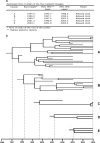Demonstration of sustained drug-resistant human immunodeficiency virus type 1 lineages circulating among treatment-naïve individuals
- PMID: 19158238
- PMCID: PMC2648277
- DOI: 10.1128/JVI.01556-08
Demonstration of sustained drug-resistant human immunodeficiency virus type 1 lineages circulating among treatment-naïve individuals
Abstract
Transmission of human immunodeficiency virus (HIV) drug resistance is well-recognized and compromises response to first-line therapy. However, the population dynamics of transmitted resistance remains unclear, although previous models have assumed that such transmission reflects direct infection from treated individuals. We investigated whether population-based phylogenetic analyses would uncover lineages of resistant viruses circulating in untreated individuals. Through the phylogenetic analysis of 14,061 HIV type 1 (HIV-1) pol gene sequences generated in the United Kingdom from both treatment-naïve and -experienced individuals, we identified five treatment-independent viral clusters containing mutations conferring cross-resistance to antiretroviral drugs prescribed today in the United Kingdom. These viral lineages represent sustainable reservoirs of resistance among new HIV infections, independent of treatment. Dated phylogenies reconstructed through Bayesian Markov chain Monte Carlo inference indicated that these reservoirs originated between 1997 and 2003 and have persisted in the HIV-infected population for up to 8 years. Since our cohort does not represent all infected individuals within the United Kingdom, our results are likely to underestimate the number and size of the resistant reservoirs circulating among drug-naïve patients. The existence of sustained reservoirs of resistance in the absence of treatment has the capacity to threaten the long-term efficacy of antiretroviral therapy and suggests there is a limit to the decline of transmitted drug resistance. Given the current decrease in resistance transmitted from treated individuals, a greater proportion of resistance is likely to come from drug-naïve lineages. These findings provide new insights for the planning and management of treatment programs in resource-rich and developing countries.
Figures




References
-
- Brenner, B. G., M. Roger, J. P. Routy, D. Moisi, M. Ntemgwa, C. Matte, J. G. Baril, R. Thomas, D. Rouleau, J. Bruneau, R. Leblanc, M. Legault, C. Tremblay, H. Charest, and M. A. Wainberg. 2007. High rates of forward transmission events after acute/early HIV-1 infection. J. Infect. Dis. 195951-959. - PubMed
-
- Cane, P. A., H. Green, E. Fearnhill, and D. Dunn. 2007. Identification of accessory mutations associated with high-level resistance in HIV-1 reverse transcriptase. AIDS 21447-455. - PubMed
-
- Cohen, O. J., and A. S. Fauci. 1999. Transmission of drug-resistant strains of HIV-1: unfortunate, but inevitable. Lancet 354697-698. - PubMed
Publication types
MeSH terms
Substances
Associated data
- Actions
- Actions
- Actions
- Actions
- Actions
- Actions
- Actions
- Actions
- Actions
- Actions
- Actions
- Actions
- Actions
- Actions
- Actions
- Actions
- Actions
- Actions
- Actions
- Actions
- Actions
- Actions
- Actions
- Actions
- Actions
- Actions
- Actions
- Actions
- Actions
- Actions
- Actions
- Actions
- Actions
- Actions
- Actions
- Actions
- Actions
- Actions
- Actions
- Actions
- Actions
- Actions
- Actions
- Actions
- Actions
Grants and funding
LinkOut - more resources
Full Text Sources
Other Literature Sources
Medical
Molecular Biology Databases

